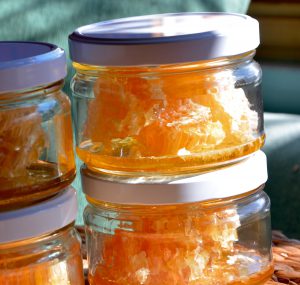Please let me know the minute more Honey is available to order

I’ve been a registered beekeeper for years. It began as a hobby and only after lots of requests did we start to sell some of the honey. We never have much to sell because the bees are kept in a permanent place on the farm. And the bees get to eat most of the honey they make. Most commercial beekeepers move their bees to wherever the honey flow is and then feed sugar, protein blocks and pollen to support them when times are tough.
Most of our hives are placed in front of the house, near the olive grove, where I can keep an eye on the comings and goings, observe the degree of busyness and the quantity of pollen on the bees’ legs. Every few weeks I fill the smoker with dry eucalyptus bark, get it smouldering, and huff and puff at the hives, carefully opening the lids and lifting the frames to see what’s happening. Who needs Tolkien when you have a magical, mysterious beehive?
The bottom box is for breeding and the top for harvesting. The queen, – the only true female – in a process called parthenogenesis, produces regiments of drones – the only true males. The queen takes a few flights from home to copulate with some of the drones, killing them in the act and returning with their severed sexual organs attached to her like trophies. Her Majesty then spends the rest of her life laying fertile eggs which, depending on the way they’re fed, produce either workers or queens.
During summer, the hive is a labour ward, full of bees being born. Having wriggled from their cells, they immediately set to work, taking wax from their stomachs and massaging it with their legs until it’s soft enough to make new cells, the hexagons of the honeycomb.
Older bees shuttle to and from the hive delivering nectar, a watery, sugary solution whose character varies according to its floral source. Crouching by the hive, watching the bees through my visor, I see the old bees kissing the new bees – but actually they’re transferring nectar. The young ones then spit it into their wax cells, where enzymes from their salivary glands thicken it while they energetically flap their wings to change the moisture level. When the right consistency is achieved you’ve got honey.
Bees are endlessly foraging, guarding, cleaning their home and each other. A single bee can visit a thousand flowers a day. Having made a discovery, it will do a little dance to show the others where they’ve been. Remarkably, during a lifetime of five or six weeks, involving visits to as many as forty thousand flowers, one bee may produce a single teaspoon of honey. So every mouthful should be savoured.
Honey is mostly sugar, water and hard work, with traces of minerals, vitamins, proteins, acids, enzymes, alcohols and esters. Volatile aromas give honey the smell of the flowers of their origin.
Our honey is available only when the bees provide an abundance.
